Washing machine connection - review
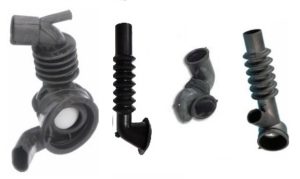 It's no secret that when caring for your washing machine, you should clean and check not only the drain, inlet hose and garbage filter, but also the pipes. The pipes for washing machines are located inside their body and are hidden from the user’s eyes, so very often they find out about problems with the pipes when they start to leak. This cannot be allowed, which is why we decided to devote this article to the issues of repair and maintenance of various washing machine pipes, but first, let’s figure out which pipes are installed in washing machines.
It's no secret that when caring for your washing machine, you should clean and check not only the drain, inlet hose and garbage filter, but also the pipes. The pipes for washing machines are located inside their body and are hidden from the user’s eyes, so very often they find out about problems with the pipes when they start to leak. This cannot be allowed, which is why we decided to devote this article to the issues of repair and maintenance of various washing machine pipes, but first, let’s figure out which pipes are installed in washing machines.
Location
In a modern automatic washing machine of standard design, three types of pipes are installed:
- water inlet pipe;
- dispenser pipe;
- drain pipe.
The water inlet pipe connects the inlet valve of the washing machine to the powder receptacle or dispenser. The “trick” is that water from the water supply, passing through the fill hose and the valve under pressure, necessarily enters the filler pipe. Quickly passing through this short pipe, water rushes into the dispenser, dissolving and carrying detergents with it.
Where does the mixture of powder and water go next? And then the soapy water leaves the powder receiver into the dispenser pipe, which actually connects the detergent receiver to the tank. Thus, soapy water, in which things are washed, enters the washing machine tank. What's next?
And then the washing machine washes the clothes, then completes the wash cycle and it becomes necessary to remove dirty water from the tank in order to rinse the clothes with clean water. The control module issues a command and the drain pump turns on.Dirty water from the tank rushes through a special hole into the drain pipe, passes through it and the pump, and then is thrown into the drain hose, and from there into the sewer. That's all.
It turns out that tap water travels all the way through the bowels of the washing machine, passing three pipes. Any of these pipes is “at risk” and can fail at any time. In particular, a layer of limescale accumulates inside the water inlet pipe, which over time can clog the pipe and the water pressure will simply tear the soft rubber.
For your information! The washing machine pipes are movable and durable, but over time they become tanned, crack and, as a result, begin to leak.
In addition to limescale deposits, deposits from detergents can form and harden in the dispenser pipe. Well, the worst situation is with the drain pipe. The drain pipe fails more often than others, since dirty water and dangerous contents of the tank pass through it:
- pins;
- bra underwire;
- buttons;
- coins;
- toothpicks and so on.
So if a washing machine repairman suspects that one of the pipes has failed and is leaking, the drain pipe is the first to come under suspicion. Calling a technician to your home, as well as servicing washing machine pipes, is now quite expensive. It’s better to do all the work yourself, and we, in turn, will tell you how to clean and repair the washing machine pipes.
Let's prepare the washing machine for repair
Cleaning and repairing the washing machine pipe cannot be done without disassembling it, since all the pipes are located inside the body. In order to disassemble and not damage the “vital” parts of the machine, it is necessary to carefully prepare it for repair.What are we doing?
- Shut off the water supply to the washing machine.
- We disconnect the washing machine from electricity, water supply and sewerage, and disconnect the hoses.
- Spread a large rag on a free area of the floor.
- We take out the powder receptacle.
- We unscrew the garbage filter and drain the remaining water from the tank through the emergency drain hose, which is located next to the garbage filter.
Note! Since you unscrew the garbage filter anyway, clean it of dirt.
- Carefully move the washing machine to a free area of the floor directly on the rag.
- Carefully tilt and place the washing machine on the side wall.
At this point, the preparation of the washing machine for repair can be considered complete. We did all these manipulations so that, firstly, it would be convenient to work with the washing machine, and secondly, in order to remove residual water from the cuvette and tank, since there is a danger that water will flood the control module and the washing machine will fail. That's all. Now all we have to do is prepare a flathead and Phillips screwdriver, pliers, and we can repair the drain, filler and dispenser pipes.
Repairing the water inlet pipe
To understand whether the filler pipe is functioning or not, you need to get to it. The easiest way to do this is through the top cover of the washing machine. First, we unscrew the two screws that hold the top cover, and then with our own hands, with some effort, we move the cover towards the back wall of the washing machine. Next, lift and remove the lid.
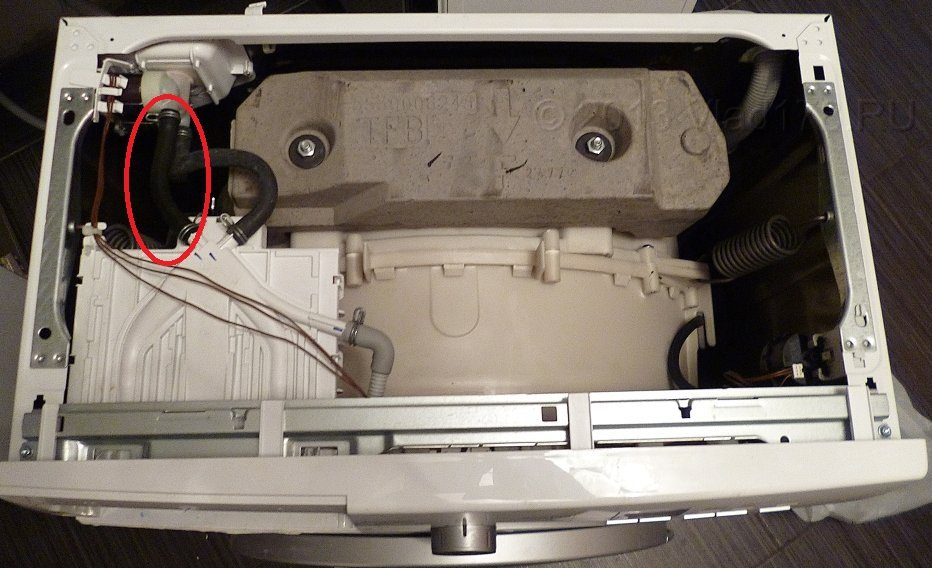
Before our eyes, in the upper left corner, we see a rubber pipe running from the fill valve to the body of the powder receiver. That's what we need. The ends of the pipe are clamped on both sides with metal clamps.Let's remove the pipe to check it thoroughly.
- Using pliers, we unclench the clamps and move them to the middle of the pipe. We will be reusing the clamps, so try not to break them.
- Very carefully, but with force, we pull the filler pipe from the valve on one side, and from the outlet of the powder receiver on the other.
- Inspect the filler pipe for blockages and damage. If there are blockages, a plastic brush will clean them, if there are none, we wash it and put it in place.
- If there is damage, we buy an original filler pipe that is suitable specifically for your model of washing machine, put clamps on it and install it in place.
Important! If the pipe has no visible damage, but is very stiff and no longer bends, it should be replaced with a new one.
Repair of dispenser pipe
The dispenser connection may require extensive cleaning and repair. Who can clean this pipe better than you, especially considering that you refused the services of a master a priori. Let's figure out where to find the dispenser pipe.

In a number of washing machine models (for example, LG washing machines), the dispenser pipe can be removed in the same way as the water inlet pipe through the top cover. But in some cases, you can get to it only by disassembling and removing the front wall of the washing machine. You can read about how to do this in the article. Disassembling the washing machine, we will not dwell on this point separately. So, what do you need to remove the dispenser pipe?
- Unscrew the screw clamps holding the pipe on both sides.
- Carefully disconnect the pipe on one side from the dispenser, and on the other from the tank.
- We inspect the pipe for blockages and damage and, if necessary, replace it with a similar one.
In theory, everything looks simple. But in practice, getting to the screws that hold the clamps in place may not be so easy. Also, do not forget that many washing machines have a flow filter mesh installed on the neck of the tank. Often, when removing the pipe, the mesh falls out, and when installing a new pipe, they simply forget to put it back - be careful. This mesh is needed and it is better to put it in place after cleaning is done.
We fix drains
The drain pipe, according to statistics, has to be cleaned and checked most often. You can get to it through the bottom of the washing machine. On models of washing machines with an open bottom, the drain pipe sticks out; once you lower the machine on its side, the pipe will be at your fingertips. If the washing machine has a tray or bottom cover, then you must first remove it, and then you will also gain access to the pipe.
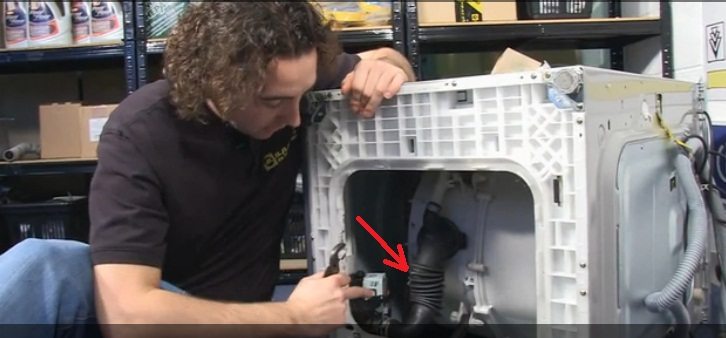
The drain pipe has three connection points: pump, tank and pressure tap hose. Our task is to loosen or press out the clamps holding the pipe at all connection points, and then simply pull it to the side. If the pipe is in satisfactory condition, use a special brush to clean it. The brush will clean it properly, then all that remains is to put the element in place. If the pipe is worn out or damaged, then it is necessary to replace it with a similar one, installing it on old clamps.
For your information! A solution of citric acid will clean the pipe well. You need to soak 100 g of lemon juice in 2 liters of water, and then put the pipe in this solution for 2 hours. Then pull out the pipe and rinse it under running cold water.
In conclusion, let’s note who can clean your washing machine better than you. The answer is obvious - an experienced master. But its services are quite expensive, and cleaning must be done regularly, including cleaning the pipes. We told you how to install, dismantle and clean the main pipes of a washing machine; we hope this information will be useful to you. Good luck!
Interesting:
Reader comments
- Share your opinion - leave a comment

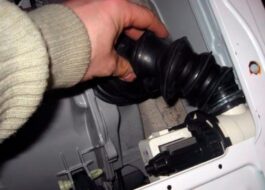



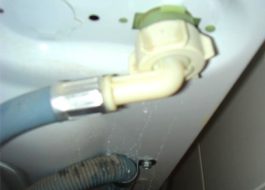
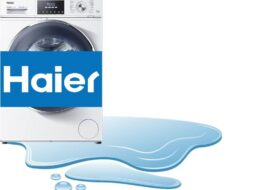














Add a comment